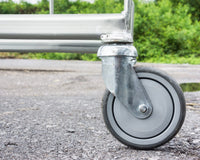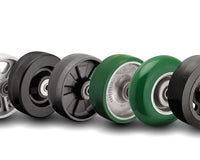A threaded stem is quite simple, it's a round piece of metal with a cut thread, as the name implies. The threaded stem is more broadly used, yet less common than the grip ring stem; because threaded stems come in nearly any size, metric or standard, small to large diameter, fine or coarse thread, the options are many. Threaded stems are available standard on institutional and furniture casters, and through special order on industrial casters.

A threaded stem provides a more secure mounting than any other stem mount. Where grip ring and grip neck stems can become loose over time, the threaded stem, short of the stem shearing, will remain in place. A fair comparison between grip and threaded stems is nails to screws.
In order for a threaded stem caster to be attached to equipment, the equipment must have a tapped bore to accept the stem. For the most part, adding the tapped bore is part of manufacturing the equipment. However, certain materials, by nature, don't accept a thread very well. In these instances certain adapters are available. Pictured to the right is an adapter for wood, it is installed by drilling a hole to the appropriate outside diameter of the adapter, then the adapter is hammered into place, secured by the webbing of the flange.
Threaded stems, as stated above, are available in nearly any size. Standard size threaded stems are generally 1/4" to 1/2" coarse. However, stems as large as 1" in diameter are readily available, although they are special order and can have a slightly longer lead time.
Noting the disadvantages, installation time is increased as compared to grip style stems. Further, the manufacturing time of the equipment may be increased due to the bore and tap requirements.
In summary, the threaded stem provides a near-universal method of caster mounting. The increased manufacturing costs can be a problem, but the secure mounting may offset this. If you have questions about your application, please don't hesitate to contact us.



